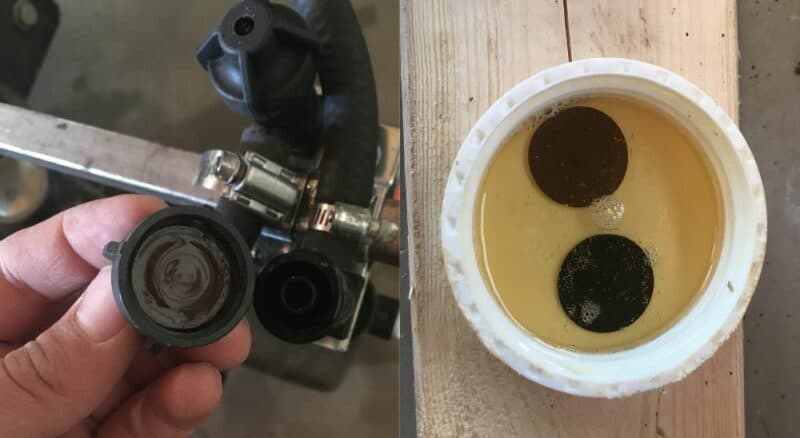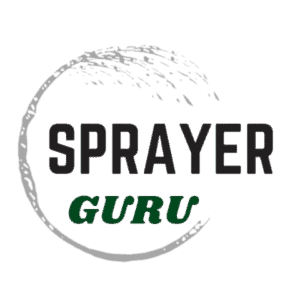Herbicides and fertilizers can be hard on spray equipment, especially seals and gaskets. Leaks are frustrating. Using sprayers and sprayer accessories built with chemical-resistant material is key to preventing premature leaks or failure. However, it can be quite difficult to know which is the best o-ring or gasket material for your application.
Both EPDM & Viton rubber is a good option for ag and turf chemicals or fertilizers. However, there are many instances where Viton is the better choice. You should consider what elastomer to use on a case-by-case basis. There are many instances where Viton may be more compatible with a specific chemical and others where EPDM will be necessary.
Let’s look at some specific chemicals and whether Viton or EPDM will work best when using them.
What is the Difference Between Viton & EPDM?
In the ag and turf world, the two major rubber types used are EPDM and Viton. EPDM is a synthetic rubber that is used in all sorts of industries. It is commonly used as sprayer hose and fertilizer/chemical transfer hose. Viton is a brand name for a specific FKM (family of fluorocarbon-based materials) product owned by Chemours and originally developed by DuPont. It is also a synthetic rubber but is made from a different mix of raw materials. It is known for its high temperature (typically 400 degrees F) resistance and wide range of chemical resistance.
While the chemical resistance of each of these rubbers can vary from product to product, we do know that EPDM does not like petroleum products. Not just fuels but even crop oils that are petroleum based are not friendly to the life of EPDM. Viton is often a better option for petroleum-based products and nitrogen fertilizers.
Determining Which One is Right for You
One way to find out what material will work best is to check with the retailer or manufacturer of the chemical or product you are handling, transporting, spraying, etc. They should be able to provide chemical compatibility guidance for their products, after all, they have to handle and transport their products themselves.
I find that often it is hard to get a conclusive answer from chemical or equipment manufacturers as to which option will work best. In this case, you may have to rely on the experience of the manufacturers or retailers of the pumps, valves, and nozzle bodies, that you are using. Be sure to provide them with as much info about your product as possible. Temperature, mix ratios, and other factors may affect the equipment and require a different approach. It is always best if you can provide an SDS sheet so that they have a full profile of the specific product.
EPDM or Viton: What is Best for Roundup?
One of the most common chemicals is Roundup or Glyphosphate. People often ask if EPDM or Viton rubber is better for use with Roundup. In order to give the best answer possible, I tested both Viton and EPDM sprayer components with Roundup and a few different liquids. Here is what I found:
I took the Viton and EPDM diaphragms that are used in my sprayer nozzle bodies and soaked them in a small cup of Roundup. These diaphragms seal the check valve in the nozzle body to keep the sprayer nozzles from dripping. They need to hold up to herbicides over a long period of time to maintain their ability to seal.
I left them in the cup for 10 days. Then I put them back into the nozzle bodies without rinsing them off. Both of them worked just fine. This was on a small boomless sprayer, and neither nozzle dripped even after multiple uses.

Over time these diaphragms will start to fail. That is the nature of using harsh chemicals, but you can expect both of these materials to hold up for some time. The amount you spray will certainly play a factor. EPDM is usually much less expensive than Viton, but Viton general will last longer.
Making Your Seals & Gaskets Last
The best practice is to follow a few basic maintenance tips to ensure you get the longest life out of the rubber components on your sprayer:
- Rinsing: Flush the components with fresh water after each use to remove any residue or chemicals that may have accumulated. This basically amounts to filling your sprayer tank with fresh water or a tank cleaner and running it through the system for a few minutes.
- Avoid prolonged exposure to harsh chemicals: EPDM and Viton rubber are resistant to a wide range of agricultural chemicals, but prolonged exposure to harsh chemicals can still cause deterioration over time. Avoid leaving the rubber components immersed in chemicals for extended periods and rinse them thoroughly after use.
- Store in a suitable environment: Extreme temperature changes and sunlight can degrade rubber materials. Store indoors if possible.
Beyond Viton & EPDM
It is also important to point out that sometimes neither EPDM nor Viton will be suitable. In this case, Teflon/PTFE may be an option. Teflon has excellent resistance to many chemicals and is widely used with fuels. Although it can be more expensive it is a great option to use when possible.
Buna is a low-cost rubber that is widely used for water, fertilizer, and petroleum products. It does not have the broad resistance to ag chemicals as EPDM or Viton, but it is widely available.
In summary, neither Viton nor EPDM is universally better for all agricultural herbicides and chemicals. The best choice depends on the chemicals you will use and their compatibility with each seal material. Sometimes the best option is to consult others in the ag or turf care industry who have experience using the same products and see what types of rubber materials have worked better for them.

